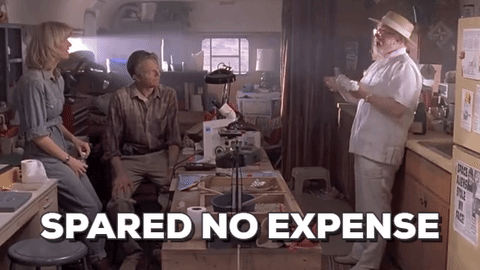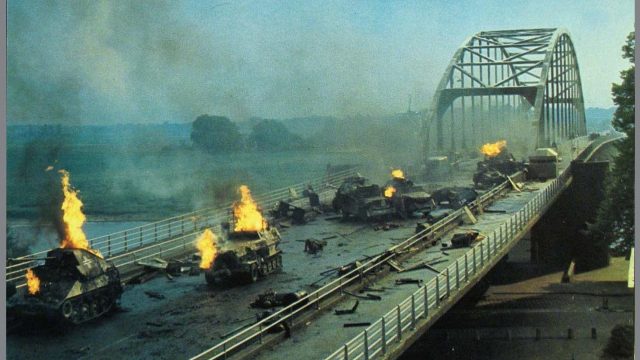A Bridge Too Far doesn’t really have much in common with Star Wars, but in a way, that’s exactly what makes it so relevant here. If Star Wars revived old genres for a new audience, Bridge was the last gasp of a style of action filmmaking whose time had passed. It’s a World War II epic that relies, like Airport, on star power to get asses in seats. This one actually has the stars to back it up, though, so many that we don’t see Liv Ullmann and Laurence Olvier’s names until several pages into the credits.
For a while, it seems like this won’t be an action movie at all, with over a half hour that’s mostly just officers sitting in boardrooms discussing their plans — but when those officers are played by Anthony Hopkins, Sean Connery, and Michael Caine, you could do worse.
But when the action hits, it really hits. It may not have had any of Star Wars’ revolutionary miniature work and prosthetic makeup, but if anything, A Bridge Too Far is even more jawdropping. Director Richard Attenborough knows the best way to convince an audience they’re watching a tank blowing up is to actually fucking blow a tank up, or at least fake it so well it’s impossible to tell the difference. At the time, it was the most expensive movie ever made, and we have actual footage of Attenborough explaining why:

Time has been kind to A Bridge Too Far. Now that this war movie formula has gone out of style, what was once stale now seems fresh to viewers like me who haven’t seen it all before. I realized this looking at Roger Ebert’s contemporary review: “A Bridge Too Far marches glumly from one cliché to the next… in William Goldman’s screenplay, we find: aristocratic British generals (and their inevitable counterparts, good blokes in the ranks), boyish Americans, Germans who march about like wind-up dolls, happy-go-lucky Irish, and, yes, even the brave Dutch lady who takes the wounded into her house. And that’s not even counting the Polish general whose first scene is a Polish joke…We find grizzled veterans and scared kids, cynical doctors with an undercurrent of heroism and stupid behind-the-lines generals, and, yes, even a scene in which the battle-scarred wounded spontaneously begin to sing ‘Abide With Me.’” — a scene that, in a vacuum, is incredibly powerful.
Not even the effects impressed Ebert: “We also find no end of explosions, taking up minute after minute of what in another film would be valuable screen time.” He even calls them “cheerfully phony,” even though they’ve aged much better than effects that were considered flawless at the time.
But Ebert’s criticisms do get at, if not a flaw, then an oddity in A Bridge Too Far. For the first two hours, it seems to be a throwback to the kind of “Hooray for our side!” war adventure movies that have been popular since World War II was still going on and laid so much of the foundation for Star Wars. But the Market Garden offensive it chronicles was a failure, and in the end we see war isn’t an adventure but an exercise in needless bloodshed. “When one man says to another, ‘I know what let’s do today, let’s play the war game.’” says Gene Hackman’s questionably accented Polish general, “Everybody dies.”
That pessimism is expressed in one of the pre-Star Wars world’s main outlets for action — the political thriller. Black Sunday is hard to recognize as a blockbuster the way we know them today. It’s the opposite of escapism, the kind of story contemporary writers liked to say was “ripped from the headlines,” shoving viewers’ faces in the everyday horrors of Palestine and Vietnam.
This might make it sound deeper than it is, but the story, based on a novel by airport-novel master Thomas Harris, doesn’t really have anything to say about these realities — they’re window-dressing, not all that different from Tatooine or the Death Star. John Frankenheimer was an unsung forerunner of the New Hollywood era, adding boldly experimental flourishes to movies like Seconds and The Manchurian Candidate, which could be ground zero for the political thrillers of the decade. But oddly enough, now that the avant garde had become mainstream, his filmmaking here is far more straightforward. Fortunately for this column, one of the most striking moments is an action sequence, where Frankenheimer creates a thrilling sense of dislocation by juxtaposing a high speed boat chase with the calm, businesslike patter of the Coast Guard on the radio. Another sequence, where feds (including another appearance by Jaws‘ Robert Shaw) chase down a machine-gun-wielding, hostage-carrying suspect through the streets of Washington DC, is more unnerving than exciting.
In Capricorn One, a Mars landing is scuttled by a contractor’s corner-cutting, and a weaselly officer (Hal Holbrook) organizes a fake one to keep NASA in tax dollars. The word “cover-up” gets thrown around, and the connection should have been obvious to viewers who lived through the Watergate scandal. The astronauts — James Brolin, Sam Waterston, and O.J. Simpson — reluctantly go along with the hoax until the unmanned shuttle fails to survive re-entry and they decide to get out of town before their bosses kill them for real.
Director Peter Hyams hasn’t had the best career, but he does fine work here. In one especially effective scene, he unnervingly emphasizes the disconnect between what we see and what we know, playing Jerry Goldsmith’s ominous score over images of the unwitting NASA ground crew celebrating their “successful” landing. And he brings the goods in the action scenes too. To get rid of Elliot Gould’s dogged reporter, the bad guys cut his brakes, and we see the results in a dizzying car’s-eye-view sequence as the camera careens wildly through downtown Houston. Hyams achieves a similar effect in the airborne climax, where our perspective spins and dives thrillingly through the sky.
But this is still very much a pre-Star Wars movie. It’s hard to imagine any Hollywood blockbuster now having the balls for the melancholy strangeness of the scene of Waterston, delirious and dehydrated after days on the run in the desert, climbing up a cliff while reciting the old joke about the cat on the roof to himself. And it’s not just cheap thrills either. There’s some of the same arch irony that allowed George Lucas to embrace the cheesiness of the movies he grew up with and have the characters snark at the plot they find themselves in instead of just going along with. A lot of the conversations in Capricorn One go even further — characters sound like they’re leaving notes on their own script.
And there’s a thread of self-reflection here on the film industry’s role in propaganda. The landing is faked on a film set, and Gould starts to put the plot together when Brolin’s wife tells him what her husband said on a visit to a ghost town during a movie shoot: “He couldn’t get over how something so fake could look so real. He kept on saying that with that kind of technology, you could convince people of almost anything.”
And with Holbrook, Capricorn seems to predict the coming Reagan era that was determined to make America feel good about itself after the self-examination of the ‘60s and ‘70s — not by solving the core problems but by hiding or even exacerbating them: “You look at what we’ve meant to this country. Nobody gives a crap about anything anymore…There’s nothing more to believe in. Now you wanna blow this whole thing wide open? God knows what it might do to everybody.” Later, he uses the astronauts’ “sacrifice” as a message of hope and optimism — a message, of course, built on lies.
In the next decade, that would become America’s big project, and Hollywood, chasing after that Star Wars dollar, would happily go along with it. Star Wars elevated action to an art form, but its success crowded out everything else, inspiring Hollywood to churn out patriotic, optimistic, escapist fantasies and ignoring the darker, stranger possibilities the movies have to offer. Now, at least as far as major releases go, there’s almost nothing else left.
Ebert reflected on the sea change in his column The Summer of ‘77: “We’ve just been through a remarkably old-fashioned summer at the movies: A summer during which the big hits were a space opera, a romantic melodrama, a thriller about sunken treasure and even one more absurdist frolic with good old James Bond….Some of these movies are really very good…They’re likely to be around for a long time, delighting us at revivals and on the late show long after some of the season’s more pretentious films have been cut up to make ukulele picks. But as someone who finds it exciting when a movie tries something new, dares to be innovative and individual, I’m of two minds about the enormous box-office successes of these essentially old-fashioned formulas….And if Hollywood thinks it has learned its lesson during the summer of 1977 and grows single-minded about turning out expensive remakes of remakes, we are going to start wondering, with the new releases of two or three years from now, if we haven’t seen all these movies before somewhere.” If only we’d listened.


